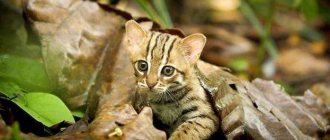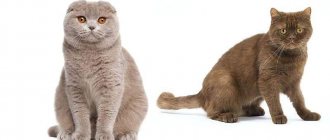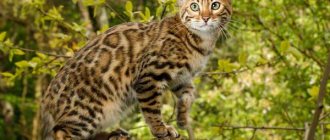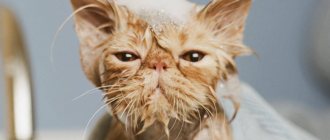Brief history of the breed
The Caraquet is a hybrid breed, the first representatives of which appeared in the 90s of the last century. This happened in the Moscow Zoo as a result of an unintentional mating of a caracal and an ordinary domestic cat. The kitten from an unplanned mating had a charming appearance and fluffy tufts on its ears. True, this was not enough for breeders to become seriously interested in them.
At the beginning of the 21st century, experiments on crossing caracals with domestic cats began to be carried out in the United States. The greatest success in this matter was achieved by Joy Geisinger, who bred a male steppe lynx with a female Abyssinian breed. The result of the American woman’s work was highly appreciated by TICA representatives, but after the woman’s death, breeding work was stopped.
Later, the experiments were continued by the owner of the Krasnodar nursery KATALEYA Irina Nazarova. The felinologist took the breeding of caraquets seriously and in 2020 was able to produce the third generation of kittens.
Today the breed has received official recognition from the International Cat Union (ICU). But due to the unresolved problem of infertility of male hybrids up to the fourth generation, breeding work has not yet been completed.
Cat Caracal
Price and where to buy a caraquet kitten
The outrageous breed is still in development; we have already talked about the difficulties of its birth. This all easily explains the high price of kittens. Moreover, their number in the world is not yet large at all.
global $ads_google; //data-ad-slot=”2475549904″ $ads_google = empty($ads_google) ? false : true; ?> if ($ads_google == false) {?>
$ads_google = true; ?> } ?>
The first generation baby costs up to 1,000,000 rubles
! The offspring of the second and third generations are slightly inferior in price. If there are fourth and fifth generation kittens, the breed will be approved, prices will not decrease, and may even increase.
While the work is at the very beginning, we are waiting for the further development of the home caraquet!
On the territory of Russia, there are only a few nurseries specializing in this breed. Breeders will supervise the ward; collecting information about home residence is very important.
How to name kittens
You need to choose an honorable name for such a delightful little lynx!
This is a home decoration, a family favorite, so I want to call the kitty an exotic nickname. The decision is correct, so we are considering the options in the table on what name to give the boy or girl caracat. Nickname table
| Girl | Boy | ||
| Greya Veysey Falia Margo Oira Puma Nani Dosya Ritsa Shoko | Daffy Haruka Appa Vlasa Caesaria Margosha Arda Alice Ceres Blanche | Reef Mao Pele Bosun Ikis Earl Altair Chelly Buck Gerard | Kraft Daniel Laure Armand Kai Fix Adis Sheik Khan Jean |
Interesting Facts
Although Caraquet cats were bred quite recently, many interesting things have been associated with them:
- The name of the breed has a direct bearing on its origin. The beginning is taken from the name of the wild ancestor of the caracal, and the ending means “cat” in English.
- The Caraquet is a hybrid cat breed. The offspring from the mating of a caracal with an Abyssinian has 50% wild blood and has all the characteristics of a predatory ancestor. Such cats are designated as F1 and are considered the most valuable and expensive. First generation hybrids are crossed with purebred domestic cats to produce second generation F2 kittens, which contain about 25% wild blood. Animals F3 and F appear according to the same principle. Moreover, each new generation of hybrids has fewer and fewer wild characteristics and goes through the process of socialization more easily.
- Due to the unsettled breed type of the Caracat, it is allowed to breed with Caracals, Abyssinians, Orientals, Bengals, Serengeti and Egyptian Mau.
Caraquets ®
- Caraquet – who is this?
- Is the Caraquet breed?
- History of the appearance of caracets
- About working on the program
- Caraquet F1 VIPLEO (75%)
- Caraquet F1 VIPLEO (50%)
- Caraquets F3 VIPLEO
- Caraquets F4 VIPLEO
- Feeding
- The F1 caraquet kids are sleeping sweetly...
- About education...
- Tray, toys, scratching posts...
Author: Kuzmina Anna Date: 01/08/2018
Caraquet – who is this?
At the moment (03/20/2018) there are only caracat hybrids of the first and second generations (Caracat F1 and F2). I’ll tell you in order what this means, since many questions arise on this topic.
First generation kittens (first generation) must have at least 50% wild blood from the feline species (for example, serval, caracal, jungle cat, ALC). In our case, the F1 caracat must have at least 50% caracal blood. To get an F1 Caracat, one of the parents must be a Caracal. In our VIPLEO® nursery, this role is played by the male. This means that our F1 Caracat kittens have a Caracal father, and the mother is an ordinary purebred cat, since F3 Caracat females and later generations do not yet exist. And they are also needed in the correct type, color and size (which is what breeders of F1 and F2 Caracat cats are currently working on). The role of mother at the moment can be any breed or a cross of breeds suitable in type, color, size. Often they use the Abyssinian breed or its cross with other breeds (since the Abyssinian in its “pure form” is a very small cat for a caracal), the Chausie and its cross, the Oriental and its cross, etc. Our nursery also uses these breeds and crosses of breeds.
Caracal and caracat of VIPLEO nursery
What does caraket F2 mean? This means that the kitten must have at least 25% wild ancestor blood. In the pedigree of F2 Caracats, the caracal is the grandfather on the mother's side. Due to the fact that fertile male caracats do not yet exist (the first generations of males in hybrids are usually sterile), a male suitable in type, color and size from other breeds or a cross between breeds is selected as the father for F2 caracat kittens. Now work is underway to obtain later generations of F3, and subsequently F4, F5, as well as to obtain fertile male caracats. As a result of this complex and painstaking work, it is very important not to lose the beauty, type, color, tassels, and also to preserve the maximum size from the caracal ancestor! Next, it will be possible to prepare for the recognition of the Caraquet breed and its removal from the category of experimental.
A frequently asked question is: is the Caraquet breed?
I decided to make a short video and voice it, since some questions are asked very often and it’s difficult for everyone to answer the same thing in PMs and comments. These are the first generation hybrids from the caracal - caracat F1. This means that their father is a caracal, and their mother is a purebred cat. In our case, in the video, the kittens’ mother’s breed is Chausie, and our father is a young and large male caracal, whose current weight is 22 kg, he is an affectionate and completely adequate cat. Mom is an extremely affectionate and friendly cat, her weight is around 4-4.5 kg. Also in our cattery cats of other breeds and mixed breeds the CARAKET program
Due to the difference in size and a number of other features, it is very difficult to get F1 Caracat kittens and many breeders fail. Therefore, at the moment, in the whole world there are only two breeders producing F1 Caracat kittens and we are very proud of this. They are truly the most unique and rare cats in the world. Unlike servals and caracals, which we do not recommend and do not sell for apartments, caracat kittens can be kept in an apartment, live with other cats and dogs, as well as in families with small children. In the following videos I will tell you a little about feeding, maintenance, toys, scratching posts, etc.
Today, work is underway on a program for breeding the experimental breed CARAKET . But there is no breed and there cannot yet be. Only the first generations of hybrids have been obtained (Caraket F1 and F2). The breed is still far away... First, you need to get fertile male Caracats, reach the fifth generation (Caracat F5) and still invest a lot of effort and labor so that it is recognized as a breed and taken out of the experimental category. Therefore, it is incorrect to assert that the breed already exists, and even more so to proclaim someone as the “creator of the breed” Caraquet... This misleads people, gives incorrect information and looks like a deception. Yes, this is a long but interesting path and I really hope that over the years it will be possible to develop the breed and it will be recognized. Then we will all admire the beautiful Caraquets as a breed, but at the moment only hybrids are born. And it doesn’t matter who exactly breeds the breed, it is important that it exists and they look great, and in appearance they are similar to the ancestor of the caracal.
History of the appearance of caracets
The history of the appearance of caracats supposedly, according to unknown facts, began in 1998, when in the Moscow Zoo (Russia) offspring were unexpectedly born from a caracal cat and a domestic cat of an unknown breed. According to unverified information, an ordinary cat entered the enclosure in which a male caracal was kept, and soon gave birth to a kitten with tufts on its ears and an unusual color, close to the color of a caracal.
The second fact of the birth of F1 caracets dates back to 2007. Then the American breeder, the first and only breeder in the world (as of the indicated date) Joy Geisinger , who later became the curator of the experimental Caracat breed at the international cat association TICA, invested a lot of effort and labor in its promotion.
It was she who carried out the planned crossing of a domestic Abyssinian cat and a Caracal cat, as a result of which the offspring of first generation kittens (Caracat F1) were obtained. Unfortunately, in 2008, Joy died of a sudden heart attack and work in this direction was suspended. Caracat F2 Date of birth: April, 2011 Breeder: Allison Navarro Owner: Teralee A. Harral Photo: September, 2018
Later, thanks to the work of another breeder Allison Navarro (pictured), it was possible to obtain first and second generation hybrids from the caracal - caracat F1 and F2 . Due to current life circumstances, further work on the development of the experimental caraquet breed and other savannah hybrids (which she also successfully worked on) Allison Navarro was suspended in 2015. The caracat kittens obtained as a result of this work still delight their owners.
In Russia in 2014, the first generation F1 hybrids were born. Then these wonderful kittens appeared in Ukraine.
At the moment, our VIPLEO® nursery is one of only two in the world that can produce these precious kittens. In addition, today there are several successful breeders in Russia working to produce F2 Caracats. Our nursery also works towards obtaining decent F2 caracats that are suitable in type, size and color.
We hope for successful continuation of work on the future breed by all Caraquet breeders and wish us all good luck!
About work on the program “Caraquet of our nursery VIPLEO®”
It turns out that we were the first in the world to receive CITES for Caracat F1 ! The first legal Caracat kittens with a full package of documents were born in our nursery! In addition, all Caracat kittens born in our VIPLEO® nursery have a state confirmation of the birth of first-generation hybrids from a caracal (caracal and domestic cat) and second generation (female first-generation hybrid from a caracal and a domestic cat)! All Caracat F1 and F2 are registered with TICA , and this is already more than 20 individuals. We manage to get very beautiful, large, pre-registered experimental breed standard Caraquet kittens. And more additions are expected soon!
Our VIPLEO® nursery officially operates under the Caraquet . The nursery is constantly working to obtain suitable females and males for the Caraquet program . This is very responsible and takes a lot of time, effort and patience. But at the same time, it is a very interesting and enjoyable job. Observing the results, you want to invest and develop even more. The results of our work are displayed in both TICA and CITES , since we are dealing with hybrids and, first of all, all our successes must be recorded officially, without breaking the law. Our Caracat kittens, starting from 2020, have all state documents, acts, origins, official registrations. OUR CARAQUETS are the FIRST in the WORLD (!!!) cats that are registered in the international organization CITES . These are the first legal Caracat kittens in the world! Since 2020, we regularly receive CITES for our Caracat kittens.
CITES Certificates
We are intensively working on the “Karaket” program: publications in magazines, on Internet resources, at exhibitions and television programs, and there is still a lot of interesting work ahead. A lot of work has already been done in the nursery to breed suitable males for producing F3 and F4 caracat . Thanks to this work, excellent caraquets F3 and F4 . There are many developments and plans for the future. We will inform you about the work of our nursery under the “Experimental Caraquet Breed” program.
F1 caraquets from VIPLEO kennel. Article “The first F1 caracats VIPLEO (75% caracal blood)”
Our VIPLEO graduate Nessie, F1 caracat (75% caracal blood). Age - 1 year.
Our graduate is VIPLEO Baby, F1 caraquet (75% caracal blood). Age - 1 year, weight - 15 kg.
Fortunella - caracet F1 VIPLEO (75% caracal blood)
Caracquet kitten F1 from VIPLEO cattery (75% caracal blood)
Caracats F1 from VIPLEO nursery (50% caracal blood)
Caraquets F3 VIPLEO
In the video and photo you see girls of the second litter of F3 caracats from VIPLEO®, born in the spring of 2020 (the first F3 litter in our nursery was born back in 2020).
The kittens perfectly retained all the characteristics of their caracal ancestor. Although it was very difficult to obtain kittens with such striking qualities in later generations. They are all good size and ticked. In addition, like the ancestor of the caracal, F3 kittens retain spots on their bellies and markings on their faces - vertical eyebrows and black whiskers. There are also tassels on the ears. All these F3 Caracat girls (like the girl from the 2018 litter) will participate in the future Caracat program.
Caraquet kitten F3 VIPLEO
Caraquets F4 VIPLEO
The first born F4 caracats turned out to be large in appearance, with the signs of their ancestor - the caracal. Cats have an excellent friendly character, they are people-oriented and love to be in the thick of things with the family. Today, one of the directions of our nursery is to work on improving and preserving the characteristics of the caraquet in later generations and obtaining a fertile male caraquet.
In 2020, our nursery managed to obtain not only the world's first F4 caracats, but also the first F4 caracats in blue color in 2020!
Caraquet kitten F4 VIPLEO
Feeding caraquet kittens
From mother's milk or bottled milk, kittens are transferred to minced meat made from either quail or turkey. Next, quail and turkey are given in pieces - from small to larger pieces. They also eat day-old chicks well, which, like quail, are very useful for both kittens and adult cats. We freeze all the meat and after defrosting, when the temperature reaches room temperature, the food is ready to eat, which is very important because... Cool or cold food should not be given. We also add vitamins and minerals to meat for meat-eating animals.
In America, hybrids of the first and subsequent generations are mainly fed grain-free food with a high meat content, and there is also a line of food for pure felines. They always have clean water freely available; we supply fresh water every day.
The F1 caraquet kids are sleeping sweetly...
The F1 caraquet babies are sleeping sweetly... These are babies from a caracal dad and a mother - a domestic purebred cat. From the caracal dad, the kittens inherited black ears (by the way, translated from Latin “Caracal caracal” means black ear), as well as spots on the tummy and a clean, spotless color on the body. If we talk about size, then at this age they are already much larger than ordinary kittens, which is also the merit of the caracal dad.
But in behavior they are much softer than caracals. And the mother cat tried to do this, not only reducing the size of the kittens relative to the caracal, but also improving their temperament, and also muffled the “wild” blood.
It is this characteristic feature that allowed F1 caracets (unlike caracals, which can only live in houses with an enclosure) to live in ordinary apartments, with small children and other animals.
The weight of an adult F1 caracat is about 10-15 kg. Males are usually larger than females.
Raising Caraquet Babies
This is how VIPLEO® children are raised from infancy. Constant communication with a person from birth is very important for any breed of kittens and especially for hybrids. Thus, people become family for them from the first days of their life.
Tray, toys, scratching posts...
As you can see in the video, they go to the litter box, just like regular cats. At the same age as in the video, we already install a large tray. We use wood filler. We have tried all types of cat litter. But due to the fact that many kittens, when exploring the world, play not only with toys, but also with filler, which they taste, we decided that wood filler is safer at a young age. It’s also good that as they grow up, they can easily switch from this filler to any other. If a new family wants to change the filling, there will be no problem. We buy different toys. If you buy in the cat department, you need to choose durable and high-quality toys, as there is a danger of chewing and swallowing small objects and parts. You can also find a lot of interesting things in the dog department. It’s not for nothing that they call us cat-dogs!
When kittens grow up, they play well with a plastic bottle, chase potatoes, apples and other suitable objects. Of course, you need to be careful about your kittens’ toys and change them on time. They love a variety of scratching posts - both with rope and croton. We also have rugs with hard weave hanging on the walls, which they love to jump on and scratch their claws well. If you choose a gaming complex, you need to take into account that the caracat is a large cat, so the complex must be well stable and fixed. The shelves should be large enough so that when the kitten grows up, it will be comfortable to lie on and safe to jump on. From childhood, there is no need to teach a kitten to play with your hand; use either a toy or waving sticks. Hands are only for affection!
Media
Contacts: (+38)0989668888, [email protected]
To the beginning of the article Back
Breed description, standards, appearance
The caraquet is a large cat with a small head and a strong, muscular body. Despite the fact that the breed has not yet been fully formed, it has its own standard with a detailed description of the reference individual.
Dimensions and weight
Caraquets are large-sized animals with moderate sexual dimorphism. Their body length from nose to tail tip can reach 1 m. The average weight of an adult hybrid cat is 12 kg. But among caracats there are also larger individuals with a body weight of 15-16 kg.
Anatomical characteristics
A typical Caraquet cat should fit the following description:
- The head is wedge-shaped, with smoothly outlined contours, a wide convex forehead, a large nose and a pronounced, but not heavy, lower jaw. The lobe is painted black, brick or pinkish. In the last two cases it should have a dark outline.
- The eyes are large, expressive, almond-shaped, with a dark edging against the background of light “glasses”. The iris is colored amber or green. The most valuable are caraquetas with a clearly defined wild “tear path” from the inner corner of the eye to the nose.
- The ears are large and set high. There is a uniform edge on the outer and inner parts of the shell. The tips of the caraquet's ears are decorated with black tassels.
- The body is of medium length, with a broad chest, strong neck and developed, but not prominent muscles. There is a pronounced fat fold on the belly of the caraquet.
- The limbs are tall, muscular, with wide paws and oval toes.
- The tail is powerful, with a wide base and a rounded black tip.
Color and coat type
The body of the caracat is covered with short, thick, soft, ticked fur. There are white areas around the eyes and on the chin of the animal. The inside of the limbs, chest and belly of a hybrid cat are covered with lighter hair.
According to the breed standard, 4 color varieties are allowed for the Caraquet:
- Wild - with a red-brown background and black spots.
- Chocolate – with brown markings.
- Cinnamon - with a peach background and red-brown spots.
- Silver – comparable to the color of a snow leopard.
Possible breed defects
Acceptable flaws:
- gray and excessively cold shades of wool;
- closed rings on the tail and limbs;
- “necklaces” and “medallions” on the chest;
- absence of black markings on the outside of the ears.
Disqualifying faults:
- unacceptable colors;
- spots and stripes on the body;
- gray tint of the lower layer of the coat;
- tail defects;
- polydactyly.
External features of the caracal
Domestic caracals, however, like wild ones, are beautiful and graceful. They can reach high speeds and have an original appearance. It is unlikely that you will confuse them with other pets, but it is still necessary to know the distinctive features.
| Breed name | Caracal |
| Time of origin | Ancient times |
| Continent of origin | Africa, Asia |
| Lifespan | 16-20 years old |
| Average weight | 15-19 kg (as an adult) |
| Average height | 45-55 cm |
| Cost of kittens | 5000-7000 dollars |
Wool
The Caracal cat is a representative of short-haired pets. However, their fur itself is quite thick and fits tightly to the body. It is distinguished by its brilliant appearance and rigidity, which allowed the animal to survive in the wild.
Color
In most cases, caracal kittens have a sandy coat color.
However, representatives of the breed with a black fur coat are rarely found. Such kittens are much more expensive and are considered rare. The belly, chest and throat of your furry friend are distinguished by a lighter shade of fur. As the name suggests, the ears of the caracal are black (although there are cats with white ears).
Head
A large, round head with an elongated nose and a pronounced chin.
Ears
Large, long, high ears are distinguished by a pointed shape at the tip. At the very end of the ears there are small dark tassels, the height of which does not exceed 4-7 cm.
Eyes
The eyelids are outlined with darker fur, which gives the cats an elegant and sophisticated look. The eyes are round in shape. Their shade varies from light yellow to rich amber.
Tail
The tail is quite long, accounting for approximately a third of the animal’s total body size.
Body
Caracal cats are creatures that are somewhat reminiscent of a lynx in appearance. Their paws are long with large sharp claws. It is noteworthy that the animal’s front legs are much stronger than its hind legs.
Representatives of this breed were often forced to walk on sand. Therefore, on their paws they have thicker, thicker hair, which makes movement easier.
Character and temperament
Caracat is a hybrid cat with a pleasant, but rather contradictory disposition. From his wild ancestor he inherited the desire for independence and independence. Therefore, you should not expect that the caracat will turn into a pet.
Representatives of the hybrid breed inherited an affectionate, obedient and non-aggressive character from domestic cats. Curious and energetic caraquets never give up on outdoor games and enthusiastically take part in all household chores. Representatives of the breed need constant communication with people and easily tolerate changes in environment. Caracats love nature walks and road trips.
On a note. By analogy with their wild relatives, many caraquetas prefer to be nocturnal, which causes additional inconvenience to their owners. In order for hybrid cats to sleep at night, they need to be given adequate exercise during the day.
Patient and non-aggressive caraquets do not pose a danger to the owner's children. But if the child is too pushy, the hybrid cat may hiss or release its claws.
The caraquet gets along well with other pets, with the exception of decorative rodents and birds. A strong hunting instinct prevents a hybrid breed cat from making friends with hamsters or parrots.
How to choose the right kitten
The Caraquet is a rare, expensive and difficult breed to breed. You can buy a hybrid kitten only in a few specialized nurseries. When choosing, you need to pay attention to the following nuances:
- availability of pedigree and veterinary passport;
- conditions of detention;
- behavioral characteristics;
- appearance.
On a note. The most expensive are the first generation hybrids. Such cats can be recognized by the presence of black tassels on their ears, which already grow to 0.5 cm by the age of one month.
Kitten care
A Caraquet kitten from a good nursery moves to a new home no earlier than 3.5-4.5 months and only if it already knows how to eat solid food and is adapted to life in a family.
To make the process of adaptation to changed conditions easier, the small hybrid is kept in a separate room for the first 5-7 days. There is also a tray, bowls, scratching post and kitten toys.
In order for the caracat to quickly get used to its owners, it is often picked up and stroked. At first, a hybrid breed kitten may respond to any movement with a wary posture and emit a threatening hiss. But as soon as the little caracat finally gets used to it, this behavior will disappear.
Castration of caraquets
If your plans do not include getting offspring, your pet needs to be castrated or sterilized, otherwise it will mark its territory, behave nervously, and may become seriously ill in the future. As a rule, the operation is well tolerated, and after a week the animal forgets about what happened. The right time for genital removal surgery is 8–11 months. The process of preparation and rehabilitation proceeds as follows:
- 30 days before surgery (no more than a year), the animal must be vaccinated, and two weeks - treated for parasites;
- within twelve hours before surgery, a fasted diet and plenty of fluids are required;
- immediately after the operation, you need to provide the pet with peace by laying it on a bedding located on the floor;
- it is important to put an Elizabethan collar or blanket on it (for 10 days) so that there is no threat of infection of the seams as a result of licking;
- you need to regularly treat the wound with Chlorhexidine and give painkillers (only on the recommendation of a veterinarian);
- In the first days, you should not put a strain on the caracat’s digestive tract, so it is better to give raw meat in the form of minced meat.
Young individuals purchased from a nursery not for breeding will already be neutered by the breeder.
Care and maintenance
Unlike their wild relatives, caraquetas are adapted for living in city apartments. In general, caring for hybrid cats is no different from caring for representatives of other breeds:
- The coat of a hybrid cat does not require complex grooming. In normal times, the caraquet's fur is combed weekly with a rubber brush or mitten. During the molting period, the procedure for removing dead hairs is carried out every day.
- Although caraquetas are not afraid of water and can easily tolerate washing, they are bathed no more than once every 3-4 months. Bath procedures are carried out in a warm room, away from drafts. It is recommended to use shampoos for short-haired breeds.
- Typically, caracats grind their claws down on a well-attached scratching post. But if necessary, you can use a nail clipper.
- The ears of a hybrid cat are wiped once every 10 days with a cotton pad moistened with a special lotion or boiled water.
- The caracat's eyes are regularly washed to remove dark deposits in the corners. Dirt is carefully removed with a soft cloth moistened with a decoction of herbs.
Choosing a kitten
When choosing a small pet of any of the hybrid breeds, you must first verify the authenticity of its origin. You should only purchase a kitten from a trusted breeder who is ready to provide all the necessary documents.
These animals are extremely expensive, their cost can exceed one million rubles, so the risk of deception is very high.
If you do not plan to breed caraquets in the future, then it is necessary to prepare for sterilization or castration in advance, otherwise the animals will inevitably mark their territory when they grow up. It is best to buy a pet after the operation has been performed.
You need to purchase a caraqueta only from a trusted and reliable breeder.
General selection criteria:
- the baby should look healthy, there should be no fluid or unpleasant odor coming from the ears and eyes;
- the skin should be clean, without rashes and various peelings;
- the fur should be shiny and thick (not sticky, rolled, etc.);
- The optimal age of a kitten is 3–4 months;
- all necessary vaccinations must be completed;
- the kitten should not be too aggressive, but not too timid (caracats are very balanced).
Feeding the cat
The caracat is a close relative of wild cats, so it is advisable to feed it natural food. The basis of the diet of a representative of a hybrid breed should be lean, fresh meat such as beef, chicken, turkey, rabbit or quail.
The caraquet menu also includes fermented milk products, eggs, ocean fish, offal and vegetables. It is strictly forbidden to give a hybrid cat fried, spicy, salty, sweet and smoked food.
On a note. Third generation hybrids can be trained to super premium dry food like Royal Canin, Farmina, Hills or Brit Care.
Education and physical activity
The Caraquet is a temperamental and active cat. To maintain physical fitness, she needs active games using dense balls, rubber rings and latex “squeakers”. To ensure that the caraquet’s muscles are always in good shape, he is equipped with a securely fixed “sports” complex with blocks for jumping.
On a note. To avoid bites and scratches, you should not use your hands when playing with the caraquet. The owner's palms should be associated only with affection and encouragement.
Caraquets are intellectually developed animals and are easy to train. Curious cats of the hybrid breed quickly learn new skills and rules of behavior in everyday life. Caracats immediately remember their name and can, like dogs, retrieve thrown balls.
Vaccinations and antiparasitic treatment
Despite the fact that experts do not know cases of caraquets being infected with infectious diseases of domestic cats, it is recommended to regularly vaccinate them:
- from calcivirosis;
- rhinotracheitis;
- panleukopenia;
- chlamydia;
- depriving;
- rabies.
The first vaccination is given to a kitten at the age of 7-8 weeks with a mandatory repetition after 28 days. In the future, the caraqueta is vaccinated annually.
To prevent diseases transmitted by fleas and worms, a hybrid cat is systematically subjected to antiparasitic treatment. Anthelmintic drugs are given to a caracat kitten once a quarter, and to an adult cat - once every six months. The dosage of the medicine is selected on the advice of a veterinarian, taking into account the weight of the animal.
Caraquet fleas are treated with special drops or shampoos. And if a hybrid cat goes outside, it is additionally protected with an anti-parasitic collar.
Health
Due to the youth of the breed, it is too early to talk about any genetic diseases inherent in it. It is believed that caraquets inherited excellent immunity and excellent health from their wild father. Over 10 years of working on the breed, not a single case of infectious infection of caraquets has been identified, but it is better to play it safe and annually give your pet the necessary vaccinations against:
- panleukopenia;
- rhinotracheitis;
- calcivirosis;
- chlamydia;
- rabies;
- depriving.
Once every three months and before vaccination, it is necessary to carry out deworming, selecting the dose of the drug depending on the weight of the animal
It is unknown how long the life of a caracat is, but their father, the caracal, lives on average up to 18 years at home.
Pros and cons of the breed
The caraquet, like any other cat breed, has both advantages and disadvantages:
| pros | Minuses |
| Interesting appearance | Rarity of the breed |
| High intelligence | Difficulty in breeding |
| Lack of aggression | High price of kittens |
Caraquets are hybrid cats with a non-standard appearance and interesting origin. They harmoniously combine the features of a wild animal and the affectionate nature of a pet.










